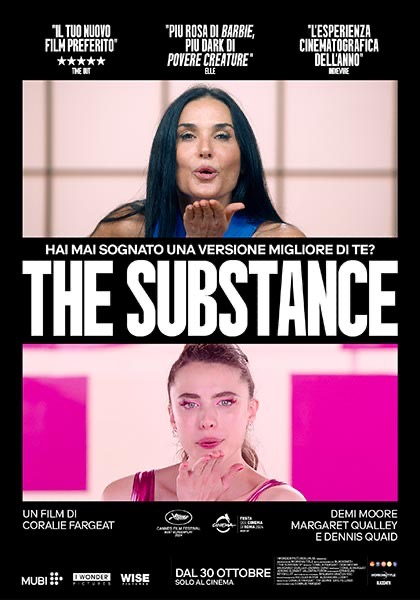In The Substance, the movie’s tension comes not just from the plot but from the deep psychological exploration of identity, beauty, and the cost of maintaining an image. Elisabeth Sparkles, once the face and body promoting health and exercise, lives under immense pressure to maintain her youthful appearance. But behind her perfectly polished facade is a more troubling truth—her self-worth is in the hands of Hollywood executives who value her for what she represents, not for who she truly is.

Elisabeth’s glamorous exterior, embodied by the younger version of herself named Sue, is the “ideal” projected to the world. Sue is the fit, toned, youthful version who gets all the gigs, the castings, the attention. But beneath the glamour, there’s a cost. Every seven days, Elisabeth must trade places with Sue, cycling between her older, tired self and this fleeting image of youth. This constant back-and-forth reflects the struggle many face in reconciling who they are now with who they used to be, or who they aspire to be in the future.
The metaphor extends even deeper: Sue is not just an external projection of beauty, but the embodiment of the past, the version of Elisabeth that once held all the promise and success. Switching back to Sue every week is like clinging to an idealized past while fearing what the future holds. It’s a trap—a never-ending cycle of striving to preserve what’s already fading.


But what happens if Elisabeth opts out of this cycle? If she stops playing by the unspoken rules of maintaining an impossible standard, she must then face herself in her present state. And here’s the haunting truth: once certain steps have been taken—once surgeries are done, once perfection is pursued—there’s no going back. The past can’t be reclaimed, and the future becomes uncertain.
The film leaves viewers grappling with a key question: when you spend so much time trying to preserve an idealized image of yourself, can you ever truly love who you are in the present? And if you decide to step away from that pressure, can you still find value in yourself, knowing what’s been altered cannot be undone? What happens when you take it too far?

This is one of the few films where textbook beautiful faces and bodies are constantly on display, yet by the end of it, I found myself still loving my own. Perhaps it’s because the film makes us question the point of beauty itself—when is enough, enough?
Is there ever a point where we stop trying to chase after the past or the future and learn to love who we are right now?
